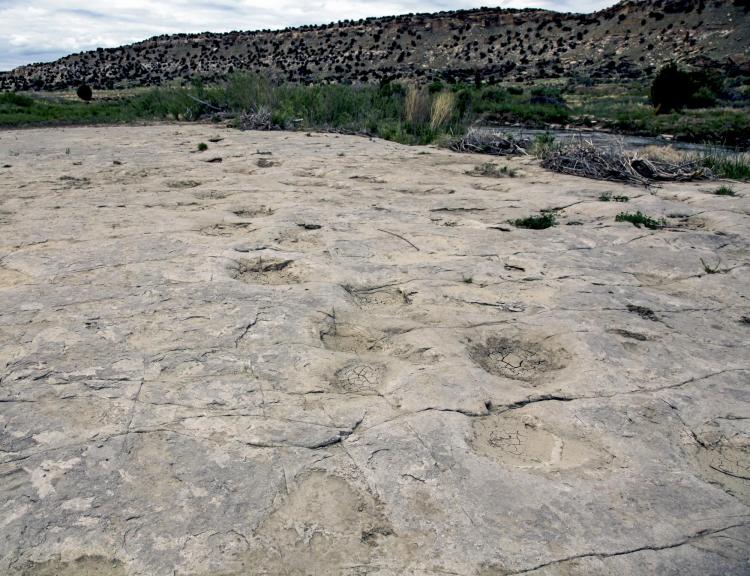Following dinosaurs along Colorado's Purgatoire River
Tracks, which predate humans by 149.8 million years, show that the apatosaurs were walking as a group, with large and small animals intermixed
More than 1,500 fossil footprints allow you to follow dinosaurs as they walked along a lakeshore 150 million years ago. The dinosaur tracksite, the largest in North America, is beside the Purgatoire River in Picketwire Canyon south of La Junta.
It is a curious story how the Purgatoire River came to flow through Picketwire Canyon. A large band of conquistadors searching for gold was exploring the area and decided to split into two bands to more efficiently search separate canyons. The sole priest had the good fortune to be in the band that survived, while Native Americans wiped out the other band. Because the soldiers died without receiving last rites from the priest, their souls were lost for eternity in Purgatory.
More than 1,500 dinosaur footprints form dinosaur tracks in the Purgatoire Canyon. Click here to see larger image. Photo by Jeff Mitton.
The river was given a Spanish name meaning "souls lost in Purgatory." Later, French fur trappers translated the Spanish name to French and later yet they shortened it to Purgatoire. European settlers had difficulty pronouncing Purgatoire, so they simplified it to Picketwire, which is now the most common name used by local residents. So today both the river and its canyon have two names: Purgatoire and Picketwire.
I hiked several miles from the campground on the rim of the canyon to the tracksite beside the river and was delighted to follow the tracks of individual dinosaurs. Two types of tracks are easily discerned. The big herbivores — including Apatosaurus, Diplodocus and Stegosaurus — had massive feet that were shaped similar to those of modern elephants, but much larger.
Apatosaurus, once called Brontosaurus, and Diplodocus had small heads on very long necks, balanced at the other end by very long tails. Stegosaurus was stockier, with a small head but two rows of large, pointed plates on its back and a powerful spiked tail for defense. These were enormous animals — Apatosaurus grew to be 80 feet long and weigh 24 tons.
Allosaurus was a smaller dinosaur, with a smaller footprint with three large, distinct toes. It grew to a length of 30 feet and a weight of 2.5 tons. Allosaurus looked similar to the famous Tyrannosaurus rex, for both were bipedal and had enormous heads, large teeth, powerful back legs, short front legs and thick tails used for balance. Allosaurus lived 80 million years earlier than T. rex and although Allosaurus was smaller, paleontologists inferred it to be a ferocious predator that hunted the much larger herbivores along the lakeshore.
Close examination of the tracks revealed that the apatosaurs were walking as a group, with large and small animals intermixed. This observation revealed that the big herbivores moved in herds, just as wildebeest, zebras, pronghorn antelope and elk do today. Herds of herbivores form in response to pressure by predators, for herds provide many eyes, ears and noses to detect predators and allow adults to mount a unified response to protect themselves and their young.
Although Allosaurus was believed to have been a fierce predator, this 2.5-ton predator might have been deterred by a confrontation with a dozen apatosaurs, each weighing 24 tons. The three-toed footprints of allosaurs are plentiful at the tracksite, but the predators seemed to be solitary — their tracks provide no evidence that they hunted in packs.
More than 80 tracks have been set in the stone of the Morrison Formation, which formed over a period of 10 million years approximately 150 million years ago. The formation was named for the town of Morrison, where the first dinosaurs in this formation were found in 1877.
That site is now called Dinosaur Ridge, for numerous quarries produced dinosaur bones and was the site where Stegosaurus, Colorado's state dinosaur, was first discovered and named. Dinosaur National Monument, in northwestern Colorado, is another site in the Morrison Formation.
A visit to the tracksite beside the Purgatoire River or Dinosaur Ridge or Dinosaur National Monument can be a memorable experience, for one is yanked from the surroundings and events of a typical day and confronted with rock solid evidence of a very different world. About 150 million years ago, immense herbivores gathered along the shores of lakes and rivers, where terrifying predators stalked them, waiting for an opportunity.
All of the plant and animal species fossilized in the Morrison Formation are extinct today. The Rocky Mountains would not begin to form for another 95 million years, and humans would not evolve for another 149.8 million years.


